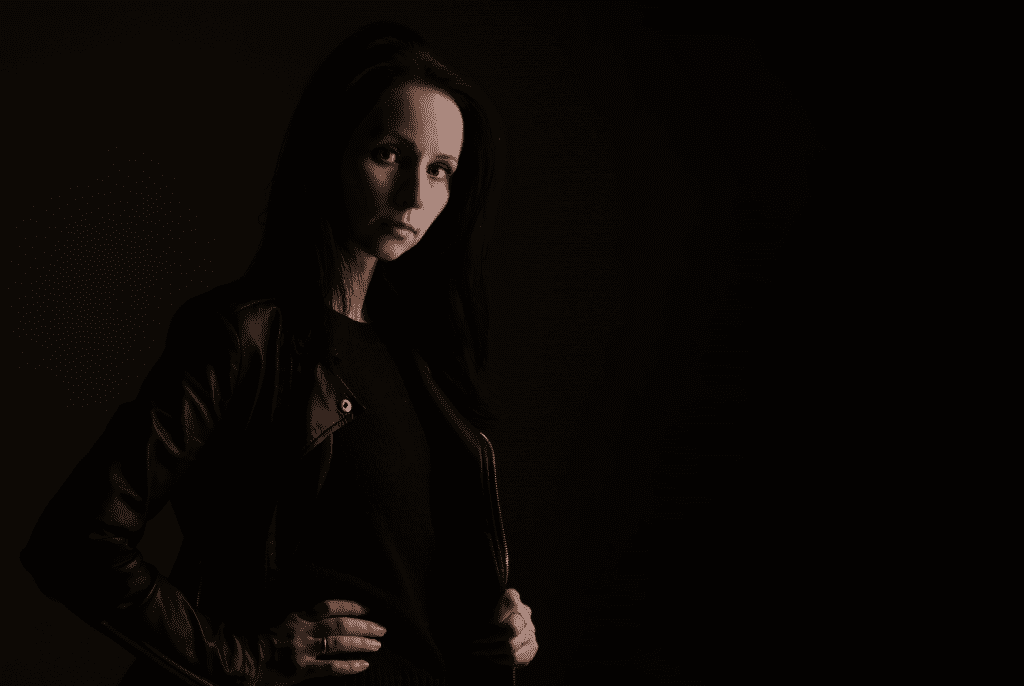
Clothing photography can be tricky for someone new to commercial shooting, and taking pictures of black clothes is an even more challenging task. Luckily, by following a few simple tips and tricks, you’ll be able to capture detailed, flattering pictures of black items regardless of your experience level.
To take good pictures of black clothes, you need to use a light background, increase the exposure setting, and work with lighting to separate your item from the backdrop. Lighting up the shadows and doing more close-up shots will also help bring out the details.
In this article, I’ll share plenty of helpful tips that will allow you to create stunning shots of your black clothing. I’ll also explain all the nuances related to photographing black items, discuss the possible struggles, and offer working solutions for anyone interested in going pro. Let’s begin!
1. Choose a Light Background
This might seem obvious; however, it’s quite a popular technique to shoot black items against a dark background. The reasoning behind it is that a darker backdrop makes the clothes seem lighter as opposed to a contrasting white or similarly-colored background.
Still, a dark backdrop makes it harder to make out the item and see the details. It’s also more challenging to get a nice shot: you need a lot of space to create a composition where the clothes would be far away enough from the background in order to make them visible.
You also need a professional camera that you have fully mastered to set up the right settings and create an image where the clothing isn’t blurred into the backdrop. Finally, if you’re shooting a model or combining your black piece with other items, you won’t get the black clothing to be the center of attention, as brighter spots in the picture will catch the eye more easily.
So, it makes more sense to stick to a light background. It doesn’t necessarily have to be white, as this color indeed contrasts with black too much and makes it seem extremely dark and less attractive.
You can experiment with other shades and colors to see which ones complement your item the best. Make sure to coordinate the backdrop with other items in the picture so everything can be clearly seen.
It’s also a good idea to shoot outside. Natural lighting and street backgrounds will work great for black clothing. Here you need to think about what other items could be added to the look to make the black piece stand out more and look appealing to potential customers.
2. Ensure You Have Good Lighting



The next thing you need to take care of is proper lighting. It can be challenging to set the lighting up in a way that highlights your black items without taking away from their look. That’s why figuring out the ideal lighting conditions is key when it comes to getting beautiful shots.
What can you change in your regular lighting set-up to bring out the black detail and make your items more visible? Well, using natural lighting would be the easiest solution. It’s a number one recommendation for amateur photographers but is especially convenient when it comes to tricky shoots, like photographing black clothes.
The main advantage of using sunlight is that it easily gives your images a natural and appealing look without you having to put in any extra work to achieve that effect. You can either shoot outside or create a set-up by a big bright window.
Still, there are some tricks you can try for studio shooting, too. For instance, you can use side lighting to focus more on the black details. On the other hand, you can light up the model a little more, directing light to his or her hair. Both approaches will let you separate the black piece from the rest of the picture and highlight it for the viewer.
Another strategy you can try is to set the light behind your model or mannequin. This easy trick will let you detach the black clothing from the backdrop in the picture. This method would be especially helpful for you if you’d like to use a darker background to avoid harsh contrasts.
3. Adjust Exposure
Exposure is another key element in creating a pretty image of black clothing. The ideal exposure settings for light and dark clothes are different, and for a good reason. We need to adjust exposure in order to bring out the details of our item, which is why this setting deserves a separate discussion.
With darker items, the general rule is that overexposure is better than underexposure. However, too much exposure can lead to the clothes not looking realistic, inaccurate color representation, and other unfortunate effects we’d like to avoid.
In order to find the perfect exposure setting, you need to try a variety of approaches and see which one works best with your item specifically. Start with lower exposure and make a few shots, gradually increasing the setting.
Go through the resulting images and pick the pictures that look the best. As mentioned, higher exposure is usually better, but it could be closer to medium in some cases. Taking several shots with various exposure settings helps you understand the difference and decide what works well for you and what doesn’t.
It could also be that while figuring the exposure out, you’ll need to move or adjust the lighting in the process. Sometimes it’s clearer what lighting you want when you see more detail in the picture. Experiment with your set-up until you find the ideal combination that showcases your clothes best.
4. Lighten Up the Shadows
When it comes to editing the pictures, there are even more tricks that can help your black clothes look more attractive. The main approach you need to try is lighting the shadows up.
Making shadows lighter is an excellent way to fix bad lighting or too much contrast in the image. If you feel like the black pieces look too dark or aren’t visible enough, try adjusting this setting and see if it helps you get a better result.
However, make sure not to rely on this editing technique too much. While it can make dark items brighter, it can also ruin the looks of your black clothing. Again, color misrepresentation is highly likely if the shadows are too lightened. It is also probable that the clothes will look washed out and ‘tired,’ which is not the impression you want to make.
If you’re facing the opposite problem (the black clothes looking washed out or not black enough in the pictures), that can be fixed, too. You can look through this tutorial to see how the color can be improved in Lightroom. It’s a convenient method that uses a brush with a specified set of settings to eliminate any faults in the shot quickly and easily.
5. Posing & Positioning
Let’s now talk about how to position clothes in your shot to showcase them most successfully. It might not be the first thing that comes to your mind when you think about the struggles of making a black piece work in an image, but it actually weighs in a lot.
If you experiment with modeling poses enough, you’ll notice how important they are for the black items to look distinguishable and attractive. Dark colors make it easy for the elements to get blurred together, looking weird and getting hard to make out in the picture.
This mainly concerns jeans and pants. A model’s legs shouldn’t be too close together, as it will be difficult to get an idea of how the item actually looks. The same goes for the sleeves: if the arms are too close to the body, all elements of the piece come together into one dark spot that looks neither distinguishable nor appealing.
You need to find natural poses that don’t look forced but still showcase your items in the best way possible. Look for inspiration online to see successful examples of black pieces photographed for commercial purposes and get some ideas for posing.
If you’re doing flat-lay, positioning black pieces gets even trickier. Avoid folding or overlapping them with other items. Go for simplistic shots that make the clothes most visible so your potential customers can quickly get an idea of how they look.
It is easier to shoot black clothes on a person than to position them right in the flat-lay technique. If you don’t have a mannequin or anyone who could pose for your pictures, you can still get an on-person shot with this helpful service.
Zmo.ai creates images of your clothes on AI-generated models. If you need to make commercial shots for promoting your clothing items, their service can be a lifesaver. It’s especially convenient when it comes to tricky tasks like photographing black items.
All you need to do is send a picture of your clothing piece and set the preferences for what the image must look like. You can fully customize the appearance of your model, which is an added bonus that helps you be more diverse and inclusive with models of different ethnicities and body types.
Yet, the most crucial benefit of this service is being able to show how the clothes would actually fit and look on a person. As mentioned, this point is especially important for black items, so if you don’t have an opportunity to create on-person shots yourself, consider using Zmo.ai.
6. Do More Close-Ups
One of the most challenging parts of photographing black clothes is capturing all the details, as the darkness of color tends to devour them all. Still, you want to get across the texture as much as possible, as well as other small elements of your item. People find the clothes more appealing if they can see their realistic detailed look.
So, apart from working with exposure, making the item stand out with the help of lighting, and editing the colors afterward, what can you do to bring out the details?
The best answer is to take more close-up shots. While all the tricks we’ve discussed will definitely improve the final picture, there is only so much you can do about the details of dark items blending in and disappearing from view.
Closer shots combined with all the advice above will let you show more elements of your black clothes and achieve that textured look you’re aiming for. Combine them with regular pictures from a distance that gives more perspective, and you’ll get the most representative and appealing shoot there is.
Again, lighting is important: make sure yours highlights the details you’re trying to show without altering the colors. Finding the perfect angle in terms of composition can be tricky too, so experiment with your shots until you get a natural and exciting image.
7. Combine With Contrasting Items
Finally, a great way to make black items more distinguishable in pictures is by combining them with contrasting clothes and complementary accessories.
When you’re putting together a look for the shoot or creating a composition for a flat-lay photograph, think about how you can highlight your black clothes with the help of other pieces. Similar to what we discussed about the backdrop, you need to have enough contrast for the main item not to blend together with others.
However, white clothes, for instance, are often too bright to serve as complementary items, but beige or light brown can softly bring out the black without making it a big dark spot in the shot.
Depending on what clothing piece you’re shooting: a shirt, a coat, or jeans, you’ll have a different set of instruments in terms of other items that can make the black stand out. Experiment with styles to see which ones can show your black clothes most appealingly.
Conclusion
Taking eye-catching photos of black clothes can be challenging; luckily, by following the tips outlined in this article, you’ll be able to achieve great results even if you’re not an experienced photographer.
Remember that proper exposure settings and flattering lighting that separates your item from the background are the keys to success. I also recommend using light backgrounds, doing more close-up shots, and picking out complementary items that help the black pieces stand out.
Sources
- Not Dressed As Lamb: 6 Tips to Help You Photograph Black Clothes Successfully
- StyleShoots: How to adjust exposure for dark or light garments
- SLR Lounge: 3 Tips When Photographing Black Clothing Against a Black Background
- Brooke Michelle Photo: How to Photograph Black Clothing (For Brighter Photographers)




